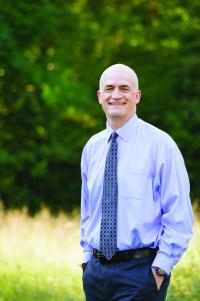Meteorologist and CEO Jan Dutton
Fall
2024
Feature
Meteorologist and CEO Jan Dutton
Molly McDonough, Graduate Student, Penn State
C7b - Dutton1.jpg

Jan Dutton.
Perhaps that’s because his father, John Dutton, was a meteorologist—first a professor at Penn State and then dean of the College of Earth and Mineral Sciences.
Although he grew up surrounded by meteorology talk, when Dutton arrived at Colby College, he became a science, technology, and society (STS) major. The STS major is less about hardcore science and more “about understanding the interactions of science and society," says Dutton.
During his sophomore year at Colby, Dutton participated in a program called Jan Plan. Lasting the month of January, the program allowed students to stay on campus for a course or participate in an offsite internship. Dutton interned at the National Center for Atmospheric Research (NCAR) in Boulder, Colorado. There, he helped one of the scientists prepare for a research mission. “I was there for basically three weeks, but it completely turned me around in terms of how awesome science is,” Dutton says.
Upon returning to Colby after his internship, Dutton declared a double major in STS and physics. He decided to pursue a physics major because Colby College didn’t have an atmospheric science or meteorology major, and he knew he needed a physical science degree to be admitted to graduate school. “Physics was the gateway drug to meteorology,” he said.
Dutton completed his senior thesis in paleoclimatology, the study of the climates during the Earth’s geologic ages, after doing some paleoclimatology research at Penn State. In his final year of undergrad, he applied to jobs and graduate school. When he didn’t get any job offers, he decided to pursue a master’s degree in meteorology at Penn State.
After earning a master’s degree in meteorology, Dutton was at a crossroads. “I realized that I didn’t necessarily want to continue [in academia] and be, say, a professor at a university or work in government,” he says. He struggled with whether to pursue an MBA, continue to a PhD program, or get a job after his master’s degree. In the end, he pursued a joint PhD/MBA program at Penn State, since he felt the MBA would set him apart from other job applicants.
Upon graduating, Dutton started his own company, Weather Ventures. The company focused on weather derivatives, financial instruments corporations once used to hedge against the risk of weather-related financial losses. Weather Ventures created a toolset to help the weather derivatives market understand how the climate forecast would likely influence the value of weather derivatives. But after the Enron crash in the early 2000s, the weather derivatives market disappeared. Dutton needed to pivot.
He joined DTN, a company that sells weather information products to airports worldwide. Dutton stayed for four years, until a private equity company acquired DTN. In the meantime, his father and a colleague had started Prescient Weather, a company focused on weather forecasting services for decision-makers in energy and agriculture. In May 2018, Dutton joined as CEO.
As CEO, Dutton spends most of his time marketing two products: Prescient Weather’s CropProphet (cropprophet.com) and the World Climate Service (worldclimateservice.com). Grain traders use CropProphet to forecast the impact of weather on yields of corn, soybeans, and wheat. Energy and natural gas companies use the World Climate Service to help manage and mitigate weather and climate risk.
Dutton says there are endless opportunities for graduates in meteorology and calls the field “the original big data science.” He encourages students to explore their interests and take classes outside of their majors. “Science is very, very important, but to be marketable, you need to try to broaden your horizons a little bit as well,” he says. “Demonstrate that you're capable of doing crisp, analytical work and then communicating about it.”
This piece is based on the August 10, 2021, episode of the podcast Clear Skies Ahead: Conversations about Careers in Meteorology and Beyond, released by the American Meteorological Society. To listen to the episode, go to bit.ly/3Wyedq7.

